English Heritage Archaeological Monographs
English Heritage, 2014. https://doi.org/10.5284/1028203. How to cite using this DOI
Data copyright © English Heritage unless otherwise stated
This work is licensed under the ADS Terms of Use and Access.
Primary contact
Historic England
The Engine House
Firefly Avenue
Swindon
SN2 2EH
Resource identifiers
- ADS Collection: 1416
- DOI:https://doi.org/10.5284/1028203
- How to cite using this DOI
Planning for the Past Volume 1: a review of the archaeological assessment procedures in England 1982-91
English Heritage (1995)
Abstract:

The issuing of Planning Policy Guidance 16: Archaeology and Planning (PPG 16) in November 1990 placed archaeological site management firmly within the structure of the planning system, recognising that 'the key to the future of the great majority of archaeological sites and historic landscapes lies with local authorities, acting within the framework set by central government, in their various capacities as planning, education and recreational authorities'. In general terms, the effectiveness of the archaeological input into planning procedures depends on three key factors , the availability to planning authorities of reliable archaeological advice provided by the staff of locally-based sites and monuments records, the inclusion within development plans of appropriate archaeological policies, and archaeological assessment procedures which provide planning authorities with detailed information on which to base decisions on the archaeological sensitivity of development proposals. This document addresses the third aspect of the archaeological planning process by providing a review of archaeological assessment procedures in the period leading up to and immediately following the issuing of PPG 16. It summarises aspects of two inter-related surveys of assessment procedures by the Universities of Bournemouth and Southampton, highlighting areas of continuing concern and making recommendations aimed at consolidating and improving on current best practice.
Download monograph
| Planning for the Past Volume 1: a review of the archaeological assessment procedures in England 1982-91, , English Heritage (1995), ISBN: 9781848021891 | 43 Mb |





